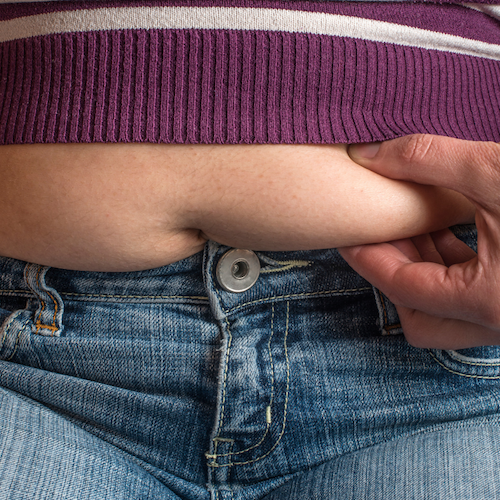Are you frustrated by that spare tire around your waist? It’s not uncommon to grow one as you get older, especially as women approach menopause and, for men, andropause.
Nobody likes the feel of belly fat hanging over their jeans, but it’s the visceral fat that we need to worry about. Visceral fat coats our organs and is associated with a higher risk for diabetes and cardiovascular disease. Belly fat is ugly but the visceral fat is actually dangerous, and both are brought on by high insulin levels.
Two hormones — insulin and cortisol — are the culprits when it comes to belly fat. Today I’ll discuss how insulin causes belly fat and three things you can do about it. Next week, in Part 2, you’ll learn about how cortisol, the stress hormone, plays a role.
Insulin is the hormone that is produced by the pancreas when it senses an increase in blood sugar from the food you eat or the stress you experience (yes, stress increases blood sugars — more on that next week).
Insulin then takes sugar out of your bloodstream and, when the system is working correctly, shuttles it into your cells to burn as fuel that gives you energy. If there is too much blood sugar circulating in the bloodstream, the cell walls shut down and no longer respond to insulin.
Any blood sugar that cannot be absorbed into the cell immediately gets turned into fat.
Here’s how it works. Your optimal fasting blood sugar level should be less than 100ng/ml, which is equivalent to 1 heaping teaspoon of sugar. That’s how much sugar should be circulating in your blood at any given time. Can you see why the 10 teaspoons of sugar in a 12oz soda is so harmful? And packs on the belly fat? As does that second (or third) glass of wine, regular cookies, and candy.
So when blood sugars are chronically high, and the cells can’t take it in, they stop responding and insulin builds up around your waist. Eventually, usually over an average of 10 years, the pancreas starts to shut down because it constantly gets the message from the pancreas that there is plenty of insulin. This is how you could develop Type II Diabetes.
As you may have guessed, keeping insulin levels low is the key to reducing belly fat and preventing adult-onset diabetes.
Here’s what to do to keep your insulin levels low:
- Avoid all processed food, especially refined carbohydrates. Avoid all sugar…yes, all! Anything with over 5 grams of sugar per serving is too much. The less sugar you eat, the less of it you’ll crave. You need to stop eating sugar to get off the cravings roller-coaster. And remember, alcohol is sugar on steroids.
- Focus on eating complex carbs, primarily vegetables. You can eat unlimited non-starchy veggies such as greens, celery, cucumbers, raw tomatoes, mushrooms, etc., to fill you up and allow your body to release the blood sugar in a slow, steady stream. Use the root vegetables, squashes, and legumes, such as beans, as your starches. Avoid human-made starches such as bread and pasta.
- Exercise! There’s no getting around it, you need exercise to use up those calories and keep the cell walls sensitive to insulin. The best form is regular, moderate to high-intensity exercise, including interval training, several times a week to keep insulin low.
In addition to the lifestyle recommendations, there are specific supplements that are very helpful in reversing insulin resistance:
- Lipoic Acid helps sensitize the cell wall to insulin; 300 mg/day, such as in Lipoic Supreme, is an excellent place to start.
- Chromium, Vanadium, Biotin, and Zinc help transport glucose through the cell wall to be converted into energy.
- We offer a great multivitamin explicitly developed for people with escalating insulin and blood sugars. It contains all the above-mentioned nutrients at higher doses plus a full complement of all the B vitamins and additional minerals.
- Omega-3 fatty acids make the cell wall more permeable so that the blood sugar can migrate through it into the cell to be used for energy.
Contact us to learn how about the supplements we offer that can help reverse insulin resistance.
Ask your doctors to test your fasting insulin levels along with your A1C, which is a three month average of your blood sugars. These two tests are the most helpful when it comes to reversing high insulin.
Try your insulin lowering program for three months and then retest to track your progress.
Good luck and BeWell!






Add Comment